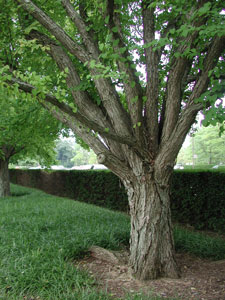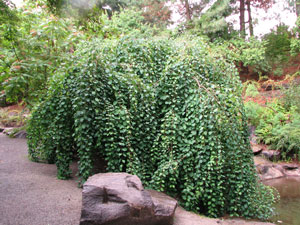Resource Library
Plant of the Week: Katsura Tree, Japanese
The University of Arkansas System Division of Agriculture does not promote, support or recommend plants featured in "Plant of the Week." Please consult your local Extension office for plants suitable for your region.
Plant of the Week
Japanese Katsura Tree
Latin: Cercidiphyllum japonicum

While a majority of our garden flowers and shrubs hail from distant lands, gardeners and the nurserymen that support their habit have mostly shunned foreign shade trees. About 80 percent of the landscape shrubs listed in nursery catalogs are exotics while, if you exclude the small flowering trees, only a couple shade trees are offered. Japanese Katsura tree (Cercidiphyllum japonicum) is one of these, yet it remains rare in landscapes.
Katsura is a large, low-branched, multi-trunked deciduous tree with a pyramidal form in its youth that becomes broad-spreading as it ages, often becoming as wide as it is tall. Though slow-growing the first few years as it becomes established, a 20-year-old tree can be expected to be 40 feet tall and wide. In Japan, it often reaches 100 feet and is the largest-growing hardwood in that country.
Katsura belongs to its own plant family, with only one genus and two species. Fossil records from the Tertiary period (younger than 65 million years) have been found in North America, but it disappeared during the cold snap that befell the planet about 5 million years ago.
As the Latin name implies, the leaves of Katsura are shaped like those of a redbud and grow from 2 to 4 inches long. When they emerge in the spring they are red, but turn blue-green as they mature. Fall color is yellow to orange, but recently cultivars have been selected that display red fall color. Katsura is dioecious, with seedlings being either male or female. The flowers are small and inconspicuous.
Katsura was introduced into the United States about 1865 by Thomas Hogg Jr. (1820–1895), who was appointed by President Lincoln in 1862 to counsel the Japanese government in establishing a customs office. Hogg remained in Japan for eight years and then returned in the 1870s for another several years. Japanese trade ports had been forcibly opened about a decade earlier when an armada of U.S. warships arrived in Kyoto Bay under the command of Commodore Matthew Perry.

Hogg was the son of a Scottish immigrant who established a nursery in New York City in 1822. With his father’s passing, Thomas and his brother inherited the firm. Many choice Japanese plants eventually made it into the American nursery trade, due to Hogg’s keen eye for what he thought would sell.
The Japanese Katsura is hardy from zones 4 through 8 and is generally well-adapted to the growing conditions found in the eastern half of the United States. It has poor drought tolerance, especially during the establishment period, so is best located in sites with deep soil profiles. Because of the tree’s height and spread, it is best used as a lawn tree or sufficiently far from the home so its spreading ways do not interfere with structures or power lines.
‘Pendula’ is a weeping form of Katsura that has a cascading habit of growth and looks like a living waterfall. It grows 25 feet tall, but given sufficient time will billow outward several times its height. This selection is from a 300-year-old tree growing at a Buddhist temple ruins in Myosenji, Japan and is sometimes offered as “Myosenji Weeping”.
By: Gerald Klingaman, retired
Retired Extension Horticulturist - Ornamentals
Extension News - December 16, 2011
The University of Arkansas System Division of Agriculture does not maintain lists of retail outlets where these plants can be purchased. Please check your local nursery or other retail outlets to ask about the availability of these plants for your growing area.